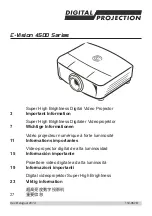
Technical Documentation
opti-check
v2.8.2-K11
305/332
ipf electronic GmbH
Lüdenscheid, Germany
15.5.2.6 Handshake
The different processing speeds of the devices in the network mean that it is often necessary to synchronise
the flow of data between the devices at application level, and therefore ensure that the data is
communicated.
There are two different handshake procedures available for this: the
simple handshake
and the
handshake
with acknowledgement
.
15.5.2.6.1
Simple handshake
Each time new data is sent, the sender inverts the handshake flag (flag bit). The receiver can then detect
that new data is being sent, even if the content of the data is the same.
Example: The same result is produced for each job analysis (e.g. identical grey value or the same distance is
measured). The handshake flag shows that a new image has been analysed and its (unchanged) results is
being sent.
General process for the simple handshake for input data for the PLC (status, result data):
1.
The PLC activates the simple handshake (outgoing handshake activation for input data bit 0).
2.
The Vision Sensor confirms the activation of the handshake (ingoing handshake activation for input
data bit 0).
3.
When it sends new data, the Vision Sensor inverts the handshake flag (ingoing handshake flag for
input data bit 4). If new data is ready to be sent, it is sent immediately with the handshake flag
inverted once again.
4.
The inverted handshake flag (ingoing handshake flag for input data bit 4) tells the PLC that new data
has arrived and it begins to process it. The PLC does not need to confirm the receipt of the data, and
this would be ignored by the Vision Sensor.
General process for the simple handshake for output data for the PLC (control, parameters, trigger data):
1.
The PLC activates the handshake (outgoing handshake activation for output data bit 0).
2.
The Vision Sensor confirms the activation of the handshake (ingoing handshake activation for output
data bit 0).
3.
When it sends new data, the PLC inverts the handshake flag (outgoing handshake flag for output
data bit 4). If new data is ready to be sent, it is sent immediately with the handshake flag inverted
once again.
4.
The inverted handshake flag (outgoing handshake flag for output data bit 4) tells the PLC that new
data has arrived and it begins to process it. The Vision Sensor does not need to confirm the receipt
of the data, and this can be ignored by the PLC.
















































